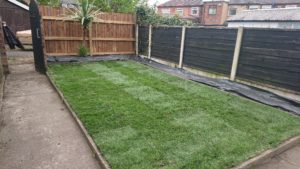Turf Laying
We lay both natural and artificial turf. Our team can come and look at the area, measure it and then advise you on the best course of action for your area.
Below is a description of the natural turfing process:



Ground Preparation
Proper ground preparation is essential for the establishment and future well-being of your new lawn. Inadequately prepared ground will never produce the best results, so it is worth putting in the time and effort at this stage.
- First, remove any existing turf by slicing beneath it with a spade. For larger areas, consider hiring a purpose-designed turf cutter from a local tool hire.
- The soil then needs to be turned over thoroughly to a depth of 15cm using a spade or a rotavator.
- Finally, clear the area of stones, weeds, old turf and other debris.
Raking
Before laying turf, the ground needs to be level and the surface should be firm but not compacted.
- Rake the area to produce a smooth, level surface.
- Then lightly tread over the surface by foot to reveal any soft patches which can then be raked level. This process should continue until the whole area is firm and level.
Laying the Turf
Now that the hard work has been done to prepare the ground, you are ready to lay your new turf. Avoid walking directly on the new lawn by using turfing boards or planks to work from and walk on.
- Start by unrolling one strip of turf around the perimeter of the lawn. Avoid using small pieces at the edges as these can dry out and perish. Ensure that the underside of the new turf is in full contact with the soil below.
- Then lay the next strip along the longest straight run and continue to work across the lawn, strip by strip producing a pattern like brickwork.
- Next butt adjoining edges and ends against each other but avoid stretching the turf.
- Lastly, overlapping pieces and ends of rows should be cut off neatly using a sharp knife or a half-moon lawn edging tool.
Watering
Newly laid turf needs to be well watered to root in and get off to a good start. The amount of watering will be dependent on the time of year that you lay the turf, with much more water needed during the summer months.
- Water your new lawn well immediately after laying, using a hose pipe or sprinkler. Continue until the water has soaked through to the soil beneath the turf layer.
- For the following week to two weeks, water your lawn well every evening (unless the rain does it for you!) The hotter, drier and windier the weather, the more water will be needed.
- Make sure to water immediately and profusely on any sign of the turf drying out. For example gaps, lifting, browning or curling.
Feeding & mowing
A healthy lawn is a well-fed lawn!
- As a rule of thumb, a balanced fertiliser containing similar levels of Nitrogen (N), Phosphate (P) and Potassium (K) should be applied every four to six weeks during the growing season.
- Always follow the manufacturer’s recommendations regarding the quantity, timing and method of application. A policy of ‘little but often’ will help maintain your lawn in peak condition.
Depending on the time of year that you lay your lawn the time of the first mow can vary, but the turf should be ready for its first mow around two weeks following laying.
- Resist the temptation to make the initial cut until your new lawn has rooted. This can be easily checked by lifting a corner to see if the roots are attached to the soil layer below.
- For the first mow, set the mower to its highest setting to avoid stressing the turf.
- Mow regularly, each time removing no more than one-third of the grass height.
- When the lawn is fully established, the height of cut can be reduced gradually to an optimum height of between 15mm and 25mm. Do this gradually to avoid scalping.
